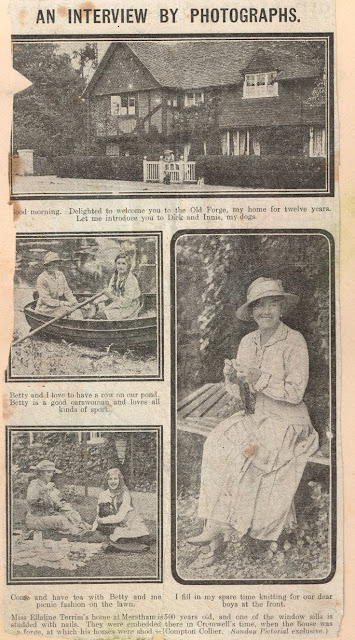Probably the most popular type of postcards to be collected
in the early 20th century, were those of Edwardian actors and
actresses. It was the golden age of British
theatre and just like today, everyone wanted to know more gossip about their
families.
Ellaline Terriss
made her London debut at the Haymarket in 1888, aged 16. She was a talented
actress and singer who began her career in musical comedies.
She was the daughter of William
Terriss, who after trying the merchant navy, tea planting in India and
farming in the Falkland Islands, had become a member of Sir Henry Irving’s
company at the Lyceum theatre. Besides
being a noted Shakespearian actor, he was also known for his swashbuckling
roles such as Robin Hood.
 |
| William Terriss |
A year earlier than Ellaline, Edward Seymour Hicks also began his career on the London stage at the age of 16. As well as becoming a popular actor he soon became a prolific author of light comedies. The public were thrilled in 1893 when he and Ellaline Terriss were married.
In December 1897 tragedy struck. William Terriss, who was known for his
kindness, had helped out a young actor, Richard Archer Prince. He gave Prince work but the young man proved
to be unstable and drank too much, so he was dismissed. Terriss sent Prince money and the Actor’s
Benevolent Society found him another part.
However, finding himself unemployed again, Prince blamed all his woes on
William Terriss, so one evening he waited outside the stage door of the Royal
Adelphi theatre, carrying a knife. When
Terriss arrived, Prince stabbed him and he sadly died. The trial was read avidly by the general
public and there was a great outpouring of sympathy for Ellaline and Seymour
Hicks.

Their popularity was immense. During the following year Seymour Hicks
co-authored “A Runaway Girl” in which Ellaline starred at the Gaiety Theatre
and the couple also adopted a four year old Irish girl, Mabel Magdalene. In 1914 Seymour Hicks recalled, “My wife saw
and fell in love with the sweetest of little Irish girls, and we adopted her,
calling her Mabel. To-day she is a sweet and gentle girl of eighteen, and is dearly
loved by us."
In 1902 Ellaline and Seymour Hicks appeared together in
Quality Street by J M Barrie. They had
recently bought a new home called The Old Forge at Merstham in Surrey and their
cul-de-sac was renamed Quality Street.
Two years later Ellaline gave birth to their baby, Betty.
Edward Seymour Hicks became so successful that in 1905 he
built the Aldwych Theatre and in 1906 The Globe, although at that time it was
called The Hicks. After 1911 Ellaline
appeared mainly in comedy and music hall.
During the First World War, the couple gave concerts to the troops at
the Front in France and in 1940 they went to the Middle East with ENSA. Having been the first British actor to
perform in France during both World War I and World War II, Hicks was awarded the
Croix de Guerre twice for his services and he was knighted in 1934.
Following the Second World War, Ellaline and Edward moved to South Africa, but after the death of Seymour Hicks in 1949, Ellaline returned to
England where she took up painting and had an exhibition in London. She died in Hampstead in 1971, aged 100.


























